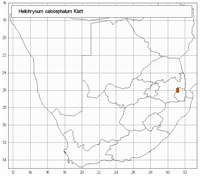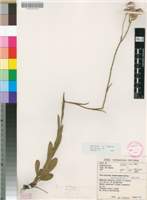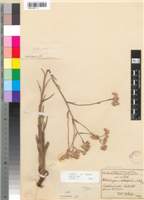Origin of name:
calli / calo, = beautiful, charming, lovely. (Greek)
cephalo= head (Greek)
Diagnostic characters:
Bracts pink
Closely branched inflorescence on long stalk
Description:
Perennial herb c. 450 mm tall, stock crowned with old fibrous leaf bases, flowering stem solitary, simple, thinly woolly, leafy near base, distantly bracteate upwards. Radical leaves up to 100 x 10 mm, a third to half the length petiolar, blade elliptic, tapering above and below, strongly triplinerved, petiole thin, wiry, base expanded, clasping, both leaf surfaces harshly pubescent; cauline leaves linear-lanceolate, apex acute to acuminate, base broad, clasping, margins strongly revolute, harshly pubescent, Heads homogamous, subglobose, c. 5 x 5 mm, many in a spreading flat-topped corymbose panicle. Involucral bracts in c. 5 series, graded, loosely imbricate, somewhat convex, tips rounded, crisped, erose, opaque white or whole head suffused pink, equaling flowers, not radiating. Receptacle with fimbrils exceeding ovaries. Flowers c. 22�29, yellow or pink. Achenes not seen, ovaries glabrous. Pappus bristles many, equaling corolla, scabrid, bases lightly fused, also cohering by patent cilia.
Flowering in September and October.
Distribution:
Recorded only from the mountains around Barberton, Mpumalanga.
Grassland Biome.
Notes:
Very closely allied to H. krebsianum but distinguished by its flowering stems only distantly bracteate upwards and by its crisped involucral bracts.
Taxonomy:
Literature:
Helichrysum calocephalum Klatt in Bull. Herbarium Boissier 4: 834 (1896); Moeser in Bot. Jb. 44: 267 (1910).
Type:
Mpumalanga, near Barberton, Saddleback Mtn, Galpin 608 (Z, holo.; BOL; K; PRE, iso.).
Synonym(s):
Vouchers:
Bolus7808 (BOL; PRE); Galpin 445 (PRE).

